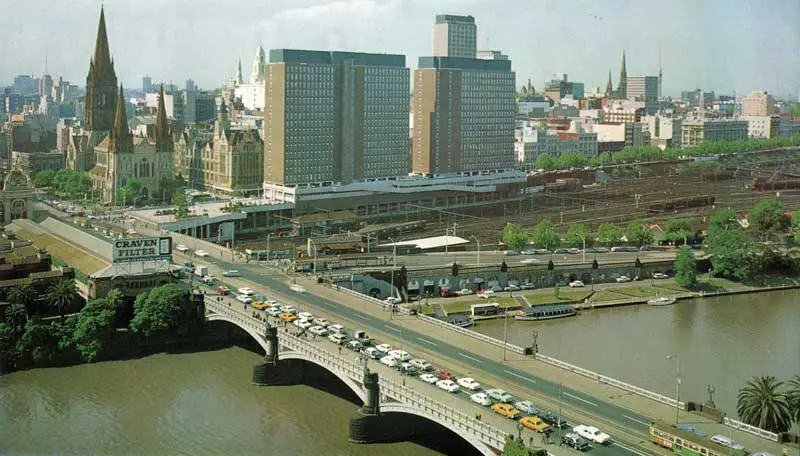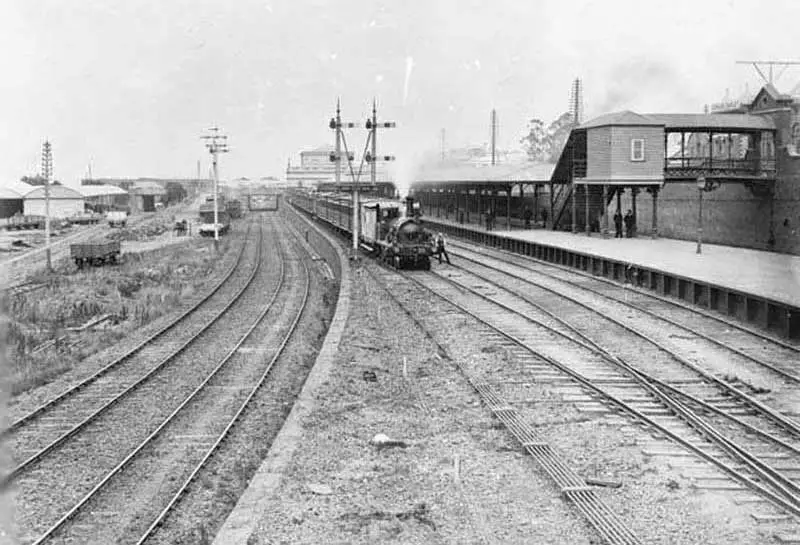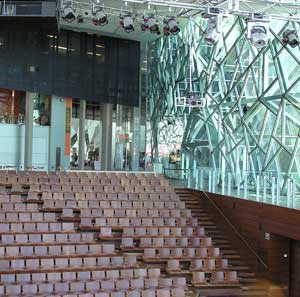
Federation Square
More than just a venue, Federation Square has now found its place as a popular meeting point for many visitors to the city, a familiar landmark where people can be found enjoying a quiet afternoon with a book, listening to live music on the stage, or viewing a sports game on the big screen.
It is a focal point for visitors too, not because of its love-it-or-hate-it exterior, but because it houses one of the most efficient, best organised tourist centres in the country where you can get a brochure on or make a booking for just about anything worth seeing or being a part of in Victoria.
Melbourne Visitor Centre
The Melbourne Visitor Centre is located underground with its entrance at the main corner shard directly opposite Flinders Street Station and St Pauls Cathedral and its exit at the opposite shard. The entrance and exit shards feature interactive news tickers in colour LEDs and small screens promoting current activities. The Visitor Centre was intended to replace a facility which was previously located at the turn of the 19th Century town hall administration buildings on Swanston Street.
The Edge
The Edge Theatre is a 450 seat space designed to have views of the Yarra River and across to the spire of The Arts Centre. The theatre is lined in wood veneer in similar geometrical patterns to other interiors in the complex. The Edge was named "The BMW Edge" until May 2013 when a new sponsorship deal with Deakin University caused it to be renamed "The Deakin Edge".
Zinc - Function and Event Centre
Zinc is a premiere event and function center located next to the BMW Edge theatre. It is primarily popular with corporate events, weddings and ceremonies.
National Gallery of Victoria
The Ian Potter Centre houses the Australian part of the art collection of the National Gallery of Victoria (NGV), and is located at Federation Square (international works are displayed at the NGV International on St Kilda Rd). There are over 20,000 Australian artworks, including paintings, sculpture, photography, fashion and textiles, and the collection is the oldest and most well known in the country.
Well-known works at the Ian Potter Centre include Frederick McCubbin's Pioneers (1904) and Tom Roberts' Shearing the Rams (1890). Also featured are works from Sidney Nolan, John Perceval, Margaret Preston and Fred Williams. Indigenous art includes works by William Barak and Emily Kngwarreye.
The National Gallery at Federation Square also features NGV Kids Corner which is an interactive education section aimed at small children and families and the "NGV Studio".
ACMI - Australian Centre for the Moving Image
The Australian Centre for the Moving Image has two cinemas that are equipped to play every film, video and digital video format, with attention to high quality acoustics. The screen gallery, built along the entire length of what was previously a train station platform, is a subterranean gallery for experimentation with the moving image. Video art, installations, interactives, sound art and net art are all regularly exhibited in this space. Additional venues within ACMI allow computer-based public education, and other interactive presentations.
In 2003, ACMI commissioned SelectParks to produce an interactive game-based, site specific installation called AcmiPark. AcmiPark replicates and abstracts the real world architecture of Federation Square. It also houses highly innovative mechanisms for interactive, multi-player sound and musical composition.

SBS headquarters
The Melbourne television and radio headquarters of the Special Broadcasting Service (SBS), one of Australia's two publicly funded national broadcasters is in one of the office buildings along Flinders Street.
Melbourne Festival Headquarters
The headquarters of Melbourne Festival (formerly Melbourne International Arts Festival) are located on Level 2 of the Yarra Building.
Beer Awards
Federation Square has recently become home to several beer award shows, and tastings, including the Australian International Beer Awards (AIBA) trade and public shows as well as other similar events such as showcases of local and other Australian breweries. These events have been held in the square's indoor outdoor area the Atrium and usually require an entry fee in exchange for a set number of tastings.
Cost: Free admission.
Location: Corner of Flinders St and Swanston St, Melbourne
Getting There:
On foot, look for the ugliest building on the Melbourne skyline and walk towards it.
By train, travel to Flinders Street Station. Federation Square is opposite the station.
Click on or tap a heading to read the description. Click or tap again to hide the description.

City Square, an initiative of the Melbourne City Council which dates back to 1968, was Melbourne's first public square. It was considered by many to be a planning failure. Its redevelopment in the 1990s failed to address serious flaws in its design as a public space and it was during this decade that the first plans for a new square were hatched by the Victorian state government. The site selected was immediately south of the Hoddle Grid and included the Princes Gate Towers of the former Gas and Fuel Corporation, the Jolimont Railway Yard and Princes Bridge railway station (which was itself the former site of a 19th-century morgue). The government jumped at the opportunity to remove two of Melbourne's great eyesores, the 1960s Princes Gate Towers, which obstructed a vista of heritage buildings along Flinders Street including St Paul's Cathedral.
The Princes Gate Towers were a set of twin office tower blocks that were located at the intersection of Flinders Street and Swanston Street, Melbourne. They were designed by architects Leslie M. Perrott and Partners and constructed in 1967. The towers were occupied by the Gas and Fuel Corporation of Victoria, leading to the buildings also being known as the Gas and Fuel Corporation Towers. They were demolished in 1997 to make way for Federation Square. An initiative of Victorian Premier Henry Bolte, the towers were named after the historic Princes Bridge located adjacent to the site. The £5 million project would cover part of the railway tracks and would feature two 15 storey office blocks along with a public plaza. The towers were designed in the International Style as a simple and functional set of extruded rectangles. The buildings were built over the still operational Princes Bridge Railway Station, which functioned as the city terminus of the Epping and Hurstbridge lines. This train station was merged with Flinders Street Station in 1980 and integrated as platforms 14, 15 and 16.

Princes Bridge Station, 1952
Built in 1859, Princes Bridge Station was the terminus for all Epping line and Hurstbridge line trains. Originally Princes Bridge station was isolated from Flinders Street Station, even though it was adjacent to it, sited just on the opposite side of Swanston Street. Some years later the railway tracks were extended under the street to join the two stations, and Princes Bridge slowly became amalgamated into the larger Flinders Street Station. The original Princes Bridge station buildings were demolished and replaced with the Princes Gate Towers, also known as the Gas and Fuel Corporation towers, with new tracks and platforms commissioned in December 1964. The site retained the name Princes Bridge Station until 29 June 1980, when it was integrated into Flinders Street Station as platforms 14, 15 and 16. The old platform space is now used as part of the Australian Centre for the Moving Image.

Jolimont Yard was an array of railway lines and carriage sidings on the edge of the central business district, located between Flinders Street Station, Richmond Junction, the Yarra River and Flinders Street. They were often criticised for cutting off the city from the river, being the site of many redevelopment proposals. The Princes Gate Towers were built over part of the yard in the 1960s, which themselves were replaced by Federation Square in the 1990s. The rail sidings themselves were progressively removed from the 1980s to the 1990s with only running lines today, but the area continues to be referred to as the 'Jolimont railyards' by Melburnians. The area of the Jolimont Yards had long been a site of railway development. Flinders Street Station was the terminal of the first railway in the city, running to Sandridge (now Port Melbourne). It was later joined by the independent Princes Bridge Station on the eastern side of Swanston Street, which served as the terminal for lines towards Richmond, South Yarra and Hawthorn. The two stations were not connected together until 1866, with Princes Bridge not reopening until 1879.










